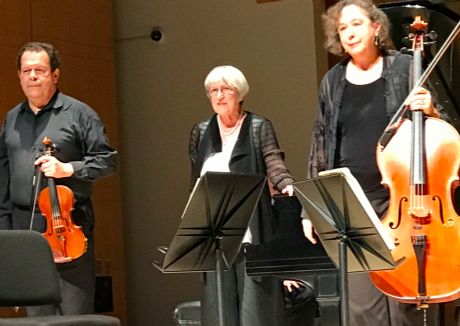|
Symphony
FROM THE NEW WORLD TO THE OLD WORLD
by Peter Lert
Saturday, June 14, 2025
Chamber
MC2 DUO RECITAL CLOSES 222'S SEASON
by Terry McNeill
Saturday, June 14, 2025
Choral and Vocal
CANTIAMO SONOMA'S LUSCIOUS A CAPELLA SINGING IN SEASON ENDING CONCERT
by Pamela Hicks Gailey
Sunday, June 8, 2025
Symphony
SRS SEASON ENDS WITH RESOUNDING TA-TA-TA-BANG
by Terry McNeill
Sunday, June 1, 2025
Symphony
YOUTHFUL VIRTUOSITY ON DISPLAY AT USO'S MAY CONCERTS
by Peter Lert
Saturday, May 17, 2025
Symphony
MYSTICAL PLANETS AND LIVELY GERSHWIN ORTIZ AT FINAL SRS CONCERT
by Peter Lert
Sunday, May 4, 2025
Symphony
VSO'S CONCERT MUSIC OF TIME, MUSIC OF PLACE
by Peter Lert
Sunday, April 27, 2025
VOCAL ELEGANCE AND FIRE AT THE 222'S RECITAL APRIL 26
by Pamela Hicks Gailey
Saturday, April 26, 2025
CANTIAMO SONOMA SINGS AN INSPIRED GOOD FRIDAY MOZART REQUIEM CONCERT
by Pamela Hicks Gailey
Friday, April 18, 2025
DRAMATIC SHOSTAKOVICH SYMPHONY CLOSES PHILHARMONIC'S 25TH SEASON
by Terry McNeill
Sunday, April 13, 2025
|
 |
 Trio Navarro April 8 in the Green Music Center's Schroeder Hall |
TRIO NAVARRO'S POPULAR FARE IN SCHROEDER HALL CONCERT
by Terry McNeill
Sunday, April 8, 2018
Long time Classical Sonoma readers may recall many Trio Navarro concert reviews that lauded their virtuosity and interest in rarely played repertoire. The April 8 concert in Schroeder Hall before 85 chamber music fans featured sterling performances but had a mostly conservative menu of popular trios. Well, with three masterpieces in the trio literature, one can’t quibble.
Rachmaninoff’s early G Minor Trio (“Elégiac”) that began the second half was the only work could be said to be uncommon, and the Navarro managed to convey the hothouse but at times lugubrious harmonies in an intense 13-minute span. Similar in many ways to the composer’s 1901 Cello Sonata in the same key, the playing of the Elégiac began with a shimmering non-stopped string sound from violinist Victor Romasevich and cellist Jill Rachuy Brindel. Pianist Marilyn Thompson played the big mid-piece solo forcefully, and it’s a noble theme with lots of notes, all of them good notes. Tempos were generally judicious.
Mendelssohn’s wonderful D Minor Trio, Op. 49, closed the program, and it’s arguably the most performed classical piano trio, and fits the Navarro like an old slipper. As Ms. Brindel set out the noble first theme I thought of how many times she must have played the same notes as a student, in rehearsals and in concerts. One thousand times? Five thousand? In the molto allegro Mr. Romasevich varied his phrasing in repeats, the ensemble was balanced and the D minor key potently presented. String vibrato was deft, limited at times, and wide at times.
In the lovely andante and elfin spritzy scherzo the performance was fluid, especially in the richly poetic andante where the wistful piano line leads into music refined and grateful for each of the instruments. Nothing sounded affected or outsized. The finale (allegro assai) was also impeccably fluid, but I kept listening for more piquant inner voices, as for example in interpretations where on page 41 the performer plays an ascending piano line in triplets with two jolting dissonance chords. Dissonance in Mendelssohn? Rarely from the elegant Navarro in this music, or at least not in this concert.
In a slight programming twist, the afternoon’s major work, Schubert’s B Flat Trio, D. 898, occupied the entire first half. It’s a long work, lyrical and then dramatic at turns, and the opening allegro moderato had a beautiful second theme statement by Ms. Brindel, quickly taken over by Mr. Romasevich. The playing was muscular when needed and the manifold key modulations, lots and lots of them, made the many sections sound fresh. The radiant themes played in the andante surely tugged many listeners’ heartstrings, and recalled Anton Rubinstein’s comment: “Ah, Schubert, eternal sunshine in music.” Schroeder’s stage piano has warmly voiced hammers and Ms. Thompson was everywhere attentive to her partners and their beguiling and florid string lyricism, never covering them.
Listeners looking for an interpretation of old fashioned romanticism, such as the legendary Cortot-Thibaud-Casals recordings of the Schubert and the Mendelssohn, did not find it in the Navarro’s approach. As throughout the afternoon a warm blended sound seemed their goal, with less interest paid to sharply etched instrumental lines, extended ritards or even minimal departures from the printed score.
With the chamber music season ending there is no reason to alter the long past observation that the exalted Navarro is the preeminent resident piano trio in Northern California.
|

